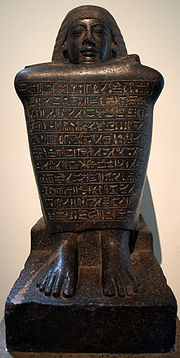
Amenhotep (Huy)
Encyclopedia

Amenhotep III
Amenhotep III also known as Amenhotep the Magnificent was the ninth pharaoh of the Eighteenth dynasty. According to different authors, he ruled Egypt from June 1386 to 1349 BC or June 1388 BC to December 1351 BC/1350 BC after his father Thutmose IV died...
in the Egyptian 18th Dynasty. With this title he was one of the highest officials at the royal court. Amenhotep, with the nickname Huy, was a member of an influential family. His father Heby was mayor of Memphis. His brother Ramose
Ramose
Ramose was an ancient Egyptian name, meaning "Born of Ra". A variant of the name is Ramesses; Egyptologists usually use the Ramesses variant for pharaohs and Ramose for non-royals...
was vizier under Amenhotep III. His son Ipy was high steward under Akhenaten
Akhenaten
Akhenaten also spelled Echnaton,Ikhnaton,and Khuenaten;meaning "living spirit of Aten") known before the fifth year of his reign as Amenhotep IV , was a Pharaoh of the Eighteenth dynasty of Egypt who ruled for 17 years and died perhaps in 1336 BC or 1334 BC...
. The family member's accomplishments are one of the rare cases where an influential family kept its high position under the latter king.
Amenhotep is known from a high number of monuments. In Memphis
Memphis, Egypt
Memphis was the ancient capital of Aneb-Hetch, the first nome of Lower Egypt. Its ruins are located near the town of Helwan, south of Cairo.According to legend related by Manetho, the city was founded by the pharaoh Menes around 3000 BC. Capital of Egypt during the Old Kingdom, it remained an...
, there was found a statue reporting his building work for his king. Another fine statue was found at Abydos
Abydos, Egypt
Abydos is one of the most ancient cities of Upper Egypt, and also of the eight Upper Nome, of which it was the capital city. It is located about 11 kilometres west of the Nile at latitude 26° 10' N, near the modern Egyptian towns of el-'Araba el Madfuna and al-Balyana...
. Already in the early 19th century, there was found in Saqqara
Saqqara
Saqqara is a vast, ancient burial ground in Egypt, serving as the necropolis for the Ancient Egyptian capital, Memphis. Saqqara features numerous pyramids, including the world famous Step pyramid of Djoser, sometimes referred to as the Step Tomb due to its rectangular base, as well as a number of...
his looted tomb. It contained a sarcophagus, a granite canopic chest
Canopic chest
Canopic chests are cases used by Ancient Egyptians to contain the internal organs removed during the process of mummification. Although the first proven canopic burials date from the 4th Dynasty reign of Sneferu, there is evidence to suggest that there were canopic installations at Saqqara dating...
, model scribal board
Scribe equipment (hieroglyph)
The ancient Egyptian Scribe equipment hieroglyph, Gardiner sign listed no. Y3, , portrays the equipment of the scribe. Numerous scribes used the hieroglyph in stating their name, either on papyrus documents, but especially on statuary or tomb reliefs.The hierolyph contains the 3 major components...
s and a stele
Stele
A stele , also stela , is a stone or wooden slab, generally taller than it is wide, erected for funerals or commemorative purposes, most usually decorated with the names and titles of the deceased or living — inscribed, carved in relief , or painted onto the slab...
with a long religious text.
Literature
- William C. Hayes: A Writing-Palette of the Chief Steward Amenhotpe and Some Notes on its Owner In: Journal of Egyptian Archaeology 24 (1938), p. 9-24
- Kurt Sethe: Urkunden der 18. Dynastie. Heft 20-22. Berlin 1957, p. 1793-1811
- Andrew Gordon: A fragmentary Palette of the Chief Steward of the King, HuyIn Göttinger Miszellen 42, Göttingen 1981, p. 23-36

